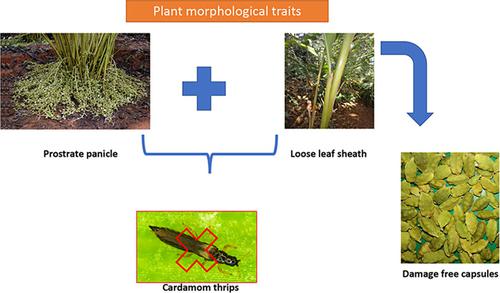当前位置:
X-MOL 学术
›
Ann. Appl. Biol.
›
论文详情
Our official English website, www.x-mol.net, welcomes your
feedback! (Note: you will need to create a separate account there.)
Plant morphological traits associated with field resistance to cardamom thrips (Sciothrips cardamomi) in cardamom (Elettaria cardamomum)
Annals of Applied Biology ( IF 2.2 ) Pub Date : 2020-05-05 , DOI: 10.1111/aab.12592 Thuruthumkara K. Jacob 1 , Chellappa M. Senthil Kumar 1 , Selvakaran Devasahayam 1 , Sharon D'Silva 2 , Rathinampillai Senthil Kumar 2 , Chakkiyanickal N. Biju 1 , Ravindran Praveena 1 , Shettahalli K. J. Ankegowda 2
Annals of Applied Biology ( IF 2.2 ) Pub Date : 2020-05-05 , DOI: 10.1111/aab.12592 Thuruthumkara K. Jacob 1 , Chellappa M. Senthil Kumar 1 , Selvakaran Devasahayam 1 , Sharon D'Silva 2 , Rathinampillai Senthil Kumar 2 , Chakkiyanickal N. Biju 1 , Ravindran Praveena 1 , Shettahalli K. J. Ankegowda 2
Affiliation

|
Cardamom thrips (Sciothrips cardamomi) is a major insect pest of cardamom (Elettaria cardamomum) causing severe economic losses to the crop in all cardamom producing countries. The present control measures rely heavily on chemical insecticides, which in addition to increased input costs also lead to pesticide residues in the produce and environmental hazards. Although the crop is of high commercial value, limited efforts have been made to identify sources of resistance to this major pest. Exploiting sources of resistance along with integrated pest management tactics will help to reduce pesticide usage in this crop promoting sustainable production. The present study aimed at identifying sources of resistance against cardamom thrips and the associated plant morphological traits conferring resistance against the pest. Field screening of 180 cardamom germplasm accessions for 3 years at Appangala, Karnataka, India, resulted in identification of eight accessions resistant to cardamom thrips. Differences in panicle type and the nature of adherence of leaf sheath to the pseudostem explained a significant amount of the variance in resistance and therefore are likely to play a major role in conferring resistance against this pest. Multiple regression analysis of the different traits indicated that accessions with prostrate panicles having leaf sheath loosely adhered to the pseudostems were found to have significantly less thrips damage, when compared with other panicle and leaf sheath types. However, persistence of flower bract did not have a significant additive effect on imparting resistance against thrips. Metabolomic analysis of the accessions may provide further insight into the existence of supplementary biochemical mechanisms, if any, in imparting resistance. The identified traits and accessions can be exploited in future breeding programmes for developing thrips resistant cardamom varieties.
中文翻译:

与小豆蔻(Elettaria cardamomum)的小豆蔻蓟马(Sciothrips cardamomi)田间抗性相关的植物形态性状
豆蔻蓟马(Sciothrips cardamomi)是豆蔻(Elettaria cardamomum)的主要害虫。)对所有豆蔻生产国的农作物造成严重的经济损失。目前的控制措施严重依赖化学杀虫剂,除增加投入成本外,化学杀虫剂还导致农产品中的农药残留和环境危害。尽管该农作物具有很高的商业价值,但是人们已经做出了有限的努力来确定对该主要害虫具有抗性的来源。利用抗药性源以及虫害综合防治策略,将有助于减少该作物的农药使用量,从而促进可持续生产。本研究旨在确定对豆蔻蓟马的抗性来源和赋予对害虫抗性的相关植物形态性状。在印度卡纳塔克邦的阿潘加拉,对180种豆蔻种质进行了3年的现场筛选,结果鉴定出了八种抗豆蔻蓟马的种质。穗型的不同和叶鞘对假茎的粘附性质的差异说明了抗药性的显着变化,因此可能在赋予对这种害虫的抗性中起主要作用。对不同性状的多元回归分析表明,与其他圆锥花序和叶鞘类型相比,带有叶鞘松散附着在假茎上的pro片的蓟马蓟马损伤明显更少。然而,花片的持久性对赋予抗蓟马的能力没有明显的累加作用。这些种质的代谢组学分析可提供对补充生化机制(如果有)的存在的进一步了解,给予抵抗。可以在将来的育种计划中利用已鉴定的性状和种质来开发抗蓟马的豆蔻品种。
更新日期:2020-05-05
中文翻译:

与小豆蔻(Elettaria cardamomum)的小豆蔻蓟马(Sciothrips cardamomi)田间抗性相关的植物形态性状
豆蔻蓟马(Sciothrips cardamomi)是豆蔻(Elettaria cardamomum)的主要害虫。)对所有豆蔻生产国的农作物造成严重的经济损失。目前的控制措施严重依赖化学杀虫剂,除增加投入成本外,化学杀虫剂还导致农产品中的农药残留和环境危害。尽管该农作物具有很高的商业价值,但是人们已经做出了有限的努力来确定对该主要害虫具有抗性的来源。利用抗药性源以及虫害综合防治策略,将有助于减少该作物的农药使用量,从而促进可持续生产。本研究旨在确定对豆蔻蓟马的抗性来源和赋予对害虫抗性的相关植物形态性状。在印度卡纳塔克邦的阿潘加拉,对180种豆蔻种质进行了3年的现场筛选,结果鉴定出了八种抗豆蔻蓟马的种质。穗型的不同和叶鞘对假茎的粘附性质的差异说明了抗药性的显着变化,因此可能在赋予对这种害虫的抗性中起主要作用。对不同性状的多元回归分析表明,与其他圆锥花序和叶鞘类型相比,带有叶鞘松散附着在假茎上的pro片的蓟马蓟马损伤明显更少。然而,花片的持久性对赋予抗蓟马的能力没有明显的累加作用。这些种质的代谢组学分析可提供对补充生化机制(如果有)的存在的进一步了解,给予抵抗。可以在将来的育种计划中利用已鉴定的性状和种质来开发抗蓟马的豆蔻品种。










































 京公网安备 11010802027423号
京公网安备 11010802027423号